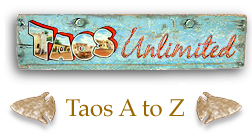|
|||
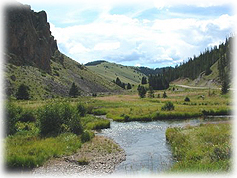 Valle Vidal Valle VidalIn 1982, the Pennzoil Company donated 100,000 acres of Vermejo Park to the People of the United States through the Forest Service, the largest and most valuable donation of private land ever made to the government. The intent of the donation was that the area was to be enjoyed for its prized wildlife resource, and for its outstanding scenic value and recuperation opportunities. The area became known as Valle Vidal, named after what the Indians and Spanish referred to as, "The Valley of Life." Since that time, Valle Vidal has been one of Northern New Mexico's most treasured outdoor recreation areas. With the state's largest elk herd, dozens of miles of rich trout streams, boundless hiking and horseback riding opportunities, and incredible wildlife viewing, Valle Vidal offers something for everyone. In 2002, the Houston-based El Paso Corporation asked the USDA Forest Service to open the Valle Vidal Unit of the Carson National Forest to mine the coalbed methane deposits located in the its eastern half. In an unprecedented action, New Mexicans of all stripes joined together to stop the potentially destructive coalbed methane drilling. Drilling for fossil fuels in the Valle Vidal would have turned this incredible area into a single-use industrial zone that few citizens would have enjoyed. Led by the Taos-based Coalition for the Valle Vidal, over 500 area governments, chambers of commerce, organizations and businesses joined together to stop the El Paso Corporation and protect the Valle Vidal. In 2005, the coalition, in conjunction with the office of Governor Bill Richardson, achieved designation of all of the surface waters in the Valle Vidal as "Outstanding National Resource Waters" under the Clean Water Act. This protective action put a significant block in El Paso Corporation's intentions to disrupt the Valle Vidal's surface and groundwater systems. The actions of the coalition were supported by over 60,000 letters to the Forest Service, as well as letters, emails, and phone calls to the New Mexico Congressional delegation. These communications came from everyone from hunters to environmentalists. However, El Paso still refused to withdraw its application to create a massive natural gas factory in Valle Vidal. To clarify the strength of northern New Mexico's wishes, U.S. Representative (now U.S. Senator), Tom Udall, introduced the Valle Vidal Protection Act of 2005 into the U.S. House of Representatives. This legislation sought to withdraw the entire Valle Vidal from jurisdiction of national mineral leasing laws, thereby assuring permanent protection from fossil fuel and other industrialization. The legislation passed the U.S. House of Representatives in the summer of 2006, and the U.S. Senate in late 2006. President Bush signed the Valle Vidal Protection Act into law on December 12, 2006. (~Aimee) 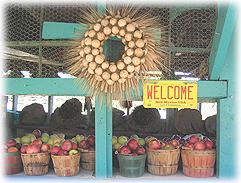 Velarde Located on NM 68 between Española and Taos, New Mexico, Velarde is set in a beautiful, lush valley on the Rio Grande. Thought of by many locals as Northern New Mexico's fruit basket, this fertile valley is filled with orchards and farms. Through the years Velarde's numerous fruit and vegetable stands have been a favorite stop along the "River Road to Taos" for locals and tourists alike. (~Aimee) Vest Definition: “a close-fitting waist-length garment, typically having no sleeves or collar and buttoning down the front.” Origin: King Charles II introduced the vest (or waistcoat) in England by Royal Proclamation on October 7, 1666. It was a simple straight cut, close-fitting garment made from black cloth with a white silk lining. Promoted personally by the King, it was soon popular with everyone. However, the political purpose was to undermine French fashion influence in England, and the vest’s simple lines was meant to defy the extravagant dictates of Versailles. The vest was based on a style brought back to England by visitors to the Persian court of Shah Abbas. It became sleeveless around the 1750s, and the garment eventually made its way to the New World. 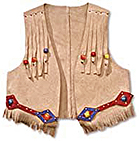 When young men began traveling out West in the 1860s, they brought the current “highfalutin” Eastern fashions with them, which included tailored trousers, suitcoats and vests. They simply added the Western accents, such as a cowboy hat, bandana scarf, and a gunbelt to the mix. You then had the “gentleman cowboy” look, so well depicted in the films, “Silverado,” “Wyatt Earp,” and “Tombstone.” There were also “western style” vests, made from suede and leather, with elaborate fringing. This was more the “mountain man” or “outlaw” look, also depicted in western movies. When young men began traveling out West in the 1860s, they brought the current “highfalutin” Eastern fashions with them, which included tailored trousers, suitcoats and vests. They simply added the Western accents, such as a cowboy hat, bandana scarf, and a gunbelt to the mix. You then had the “gentleman cowboy” look, so well depicted in the films, “Silverado,” “Wyatt Earp,” and “Tombstone.” There were also “western style” vests, made from suede and leather, with elaborate fringing. This was more the “mountain man” or “outlaw” look, also depicted in western movies.The fringed, Western-style vest reached an extremely high level of popularity in the late 1960s when it became almost a uniform for a generation of Hippies. Today, it is worn by people of all ages, both male and female. Whether it is used for actual daily wear, or reserved for special occasions (and/or trips to Taos and Santa Fe), it is, without a doubt, a fun fashion that has survived over the centuries. (~Jean) Vietnam Veterans War Memorial Chapel Following the death of their son, U.S. Marine Corps First Lieutenant Victor David Westphall III, Jeanne and Dr. Victor Westphall of Angel Fire, New Mexico, began construction of the Vietnam Veterans Peace and Brotherhood Chapel to honor the memory of their son and the 15 men who died with him near Con Thien, South Vietnam, on May 22, 1968. 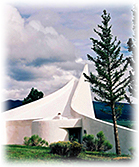 At that time, the the country was still involved in an increasingly controversial war in Vietnam, and building a memorial to honor veterans of that war was not popular. But "Doc" Westphall perservered, ultimately dedicating his life to honoring his son and the more than 58,000 others who died in Vietnam. The Chapel was dedicated on May 22, 1971, the third anniversary of the death of First Lieutenant David Westphall. It was the first major memorial created to honor the veterans of the Vietnam War, ultimately inspiring the establishment of the Vietnam Veterans Memorial in Washington D.C., which was completed over ten years later, in 1982. (~Aimee) Village Definition: “a group of houses and associated buildings, larger than a hamlet and smaller than a town, situated in a rural area; a self-contained district or community within a town or city, regarded as having features characteristic of village life.” Villages do exist in Northern New Mexico, due to the popularity of rural living throughout the area. Usually, the role of the village is to offer minimal, yet vital, services to those living in the immediate area, such as a post office, a general store, a gas station, etc. One of the most popular villages in the Taos, New Mexico, area is Arroyo Seco, known for its quaint, authentic Southwestern atmosphere. (~Jean) Pictured top to bottom: 1} Valle Vidal recreation area in Northern New Mexico; 2} Colorful fruit stand in Velarde, New Mexico; 3} Fringed, cowboy-style vest; 4} The Vietnam War Memorial in Angel Fire, New Mexico |
|||
Home | Food | Lodging | Merchants | Services | Real Estate | Art & Galleries | Entertainment | Recreation Ski Areas | Mind-Body-Spirit | Taos Information | Local Color | Taos Pueblo | High Road to Taos | Taos Plaza | Ranchos de Taos Scenic Beauty | Day Trips | Chili | Special Events | Taos History | Multicultures | Museums | The Enchanted Circle The Wild West | Taos Art Colony | Plants & Wildlife | Counterculture | Turquoise | Architecture | Features | About Us | Get Listed! Taos Unlimited Trading Post | Photo of the Week | Link of the Month | Taos Webcams | Taos Weather | Testimonials | Guestbook Taos A to Z | Movie Locations | Sitemap | Taos Unlimited Blog | Aimee & Jean's Story Blog | Contact Us | Santa Fe Unlimited |
|||

